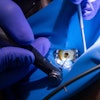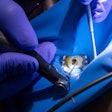
ANAHEIM, CA - In 1985, a recently fired researcher fled a top-secret laboratory with a desk drawer and a couple of boxes of paperwork. The event was the catalyst that helped expose cigarettes as addictive and eventually led to sweeping changes with how the U.S. regulates tobacco.
Victor DeNoble, PhD, was a researcher for the Philip Morris tobacco company during the 1980s. He shared his story in the keynote presentation at the California Dental Association's CDA Presents 2018 meeting in Anaheim, CA, on May 17.
"My job was to find a substitute drug for nicotine," DeNoble said. "One that would keep them addicted but that wouldn't cause heart attacks."
Part 1: The secret lab
DeNoble was initially approached by Philip Morris in January 1980 when he was a graduate student. He originally dismissed the thought of working for the company, but his advisor told him to take the interview.
 Victor DeNoble, PhD, at the 2018 CDA Presents meeting in Anaheim, CA.
Victor DeNoble, PhD, at the 2018 CDA Presents meeting in Anaheim, CA."He said, 'How much trouble can you get into?' " DeNoble said.
DeNoble officially began working as a researcher for Philip Morris on April 1, 1980. The company was very secretive about his work and went through extensive lengths to secure his laboratory.
"All the rats came into the building at four in the morning by a truck owned by the tobacco company," DeNoble said.
At the time, he and colleague Paul Mele were researching whether nicotine was addictive by studying its effects in rats, whose brains work similarly to humans. They utilized self-administration tests, a kind of test in which an animal pushes a button in exchange for a reward -- nicotine in this case.
When the rats pushed a button, they received an amount of nicotine equivalent to the amount one cigarette has for a human. Within 30 days, the rats were addicted, pushing the button up to 90 times per day for more nicotine.
"We took the nicotine out of that solution to see what would happen," DeNoble said. "The rat goes over to the switch and no nicotine. Eventually, they stop. But you put the nicotine back in, and they relapse."
DeNoble and Mele knew they were onto something big, and they wanted to publish their research. However, Philip Morris barred them from publishing.
"Between 1980 and 1984, over 25 papers on nicotine and acetaldehyde research were suppressed by Philip Morris," DeNoble said.
Part 2: The critical meeting and hidden finding
Then, in January 1983, DeNoble was called to New York City to meet with Ross Millhiser, vice chairman of Philip Morris. DeNoble and Mele told Millhiser about their work with the rats. Millhiser had only one question.
“He said, ‘Why should I risk a billion-dollar industry on rats pressing a button for nicotine?’ ”
"He said, 'Why should I risk a billion-dollar industry on rats pressing a button for nicotine?' " DeNoble said.
After that fateful meeting, DeNoble's lab was swarmed by lawyers, who categorized their research into folders of three colors: red, yellow, and green. At the time, the lawyers told DeNoble the colors meant what scientific material they understood and what they didn't. But they were actually sorting the evidence into piles to keep or destroy.
"They were going to destroy evidence, but we didn't know that until 1994," DeNoble said.
At this point, why didn't Philip Morris just fire DeNoble and Mele? Because of a substance known as acetaldehyde, DeNoble said.
Acetaldehyde is an organic chemical compound that occurs naturally in some foods, such as ripe fruit or coffee, and in 1981, DeNoble and Mele discovered that acetaldehyde was in cigarette smoke at a ratio about equal to nicotine. While acetaldehyde is not incredibly addictive on its own, they found that it was hundreds of times more addictive when combined with nicotine.
"Philip Morris kept us around because they're the only company in the world that knew there's potentially a second drug in tobacco smoke that's addictive," DeNoble said.
In fact, in 1983, unbeknown to DeNoble, Philip Morris started adding sugar to their cigarettes to increase the amount of acetaldehyde.
"Marlboro cigarettes became the best-selling cigarettes in the world because they were the most addictive cigarettes in the world," DeNoble said.
Part 3: The stolen desk drawer
But even trade secrets outlive their usefulness, and on April 5, 1985, DeNoble was fired. His supervisor advised him to return to the lab, kill the rats, turn over the keys, and leave the building. It turned out to be a crucial mistake.
"I loaded the boxes with every single top-secret file I could think of," DeNoble said. "I pulled the handle so hard to my desk that I broke the top drawer. I just stuck it in the box."
DeNoble and Mele knew they needed to get the evidence of Philip Morris's addiction research to the federal government, so DeNoble opened a phone book and called a lawyer. The lawyer promised to take the evidence to Washington, DC, but that never happened.
"He sold them to a tobacco company," DeNoble said. "We lost everything."
Fast forward to 1994. DeNoble just found out that the seven largest tobacco executives are going to testify before Congress saying that cigarettes are not addictive. His wife was understandably upset.
"My wife looked at me and said, 'What would you do if you had evidence?' " DeNoble said. "I said, 'I'd call the FBI.' She said, 'Good. What's their phone number?' "
DeNoble's wife had found the desk drawer that he had ripped from his laboratory when he was fired almost 10 years prior. And inside the drawer was a photograph of one of the rats and a self-administration test. It was the piece of evidence DeNoble needed, and he mailed it off to the FBI.
With the protection of the FBI and assurance from President Bill Clinton, DeNoble and Mele testified before the U.S. Congress just two weeks after the executives from the largest tobacco companies claimed cigarettes were not addictive. It's the picture-perfect ending to a story of secrecy and deception, but DeNoble says there's still more work to do.
Part 4: The not-so-happy ending
While combustible cigarette use has been declining for years, electronic cigarette (e-cigarette) use in on the rise, a trend that DeNoble described as scary.
"I can't tell you how many elementary and middle schools I go into, and there are boxes of electronic cigarettes," he said. "A lot of these kids don't know how electronic cigarettes work."
The major e-cigarette brands are now owned by major tobacco companies, DeNoble said, and early evidence has found that people who use e-cigarettes are three to four times more likely to have heart attacks than those who use regular cigarettes. Yet the federal government has been slow to regulate these new devices ripe for addiction.
"We know that e-cigarettes contain acetaldehyde, but there's no regulation," DeNoble said. "I want the FDA to regulate flavors in tobacco and nicotine products and to regulate the amount of nicotine that can be used."



















